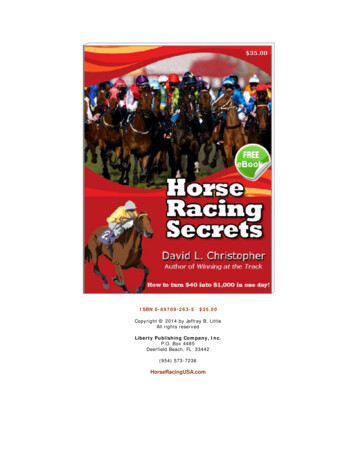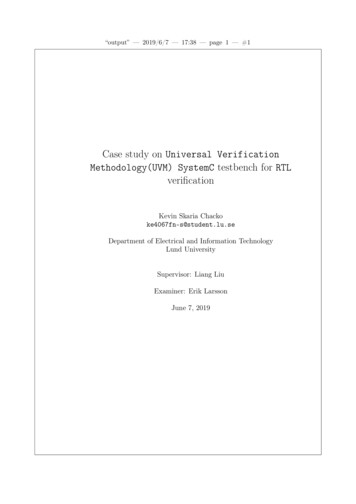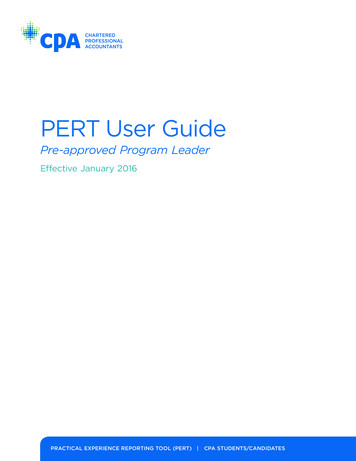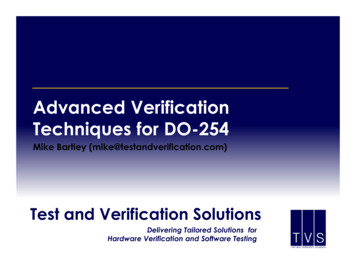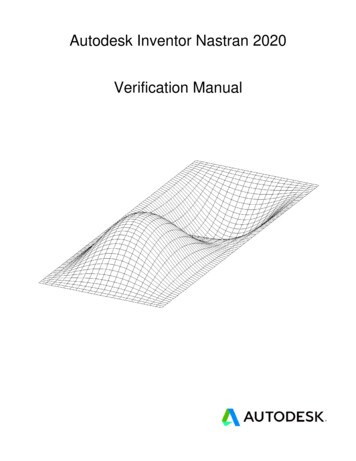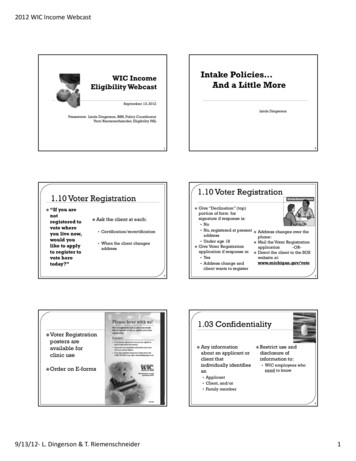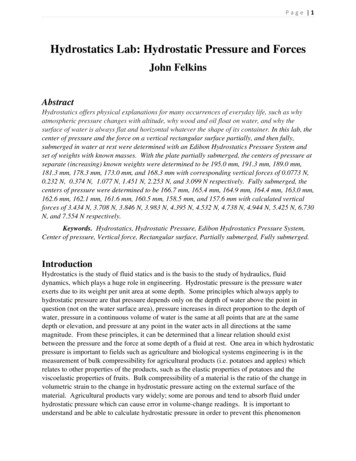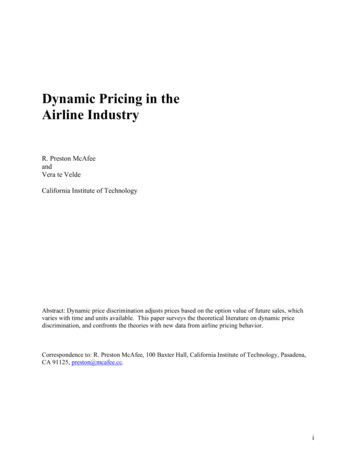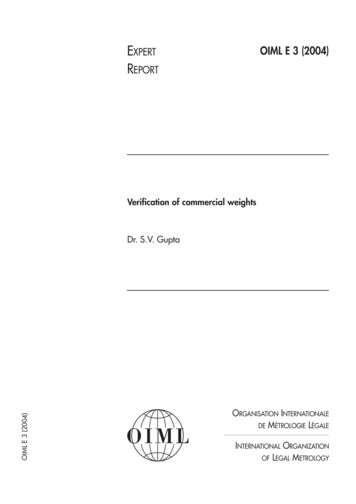
Transcription
EXPERTREPORTOIML E 3 (2004)Verification of commercial weightsOIML E 3 (2004)Dr. S.V. GuptaORGANISATION INTERNATIONALEDE MÉTROLOGIE LÉGALEINTERNATIONAL ORGANIZATIONOF LEGAL METROLOGY
VERIFICATION OF COMMERCIAL WEIGHTSContentsForewordIntroduction1Scope. 52Maximum permissible errors . 62.1Maximum permissible errors according to Indian regulations. 62.2Maximum permissible errors according to OIML R 111 (5000 kg to 100 kg) . 72.3Maximum permissible errors according to OIML R 111 (50 kg to 1 mg). 73Visual inspection. 83.1Material. 83.2Adjusting cavity. 83.3Finish . 83.4Magnetic properties . 93.5Markings. 94Shape and dimensions. 94.1Weights according to OIML Recommendation R 111 . 94.2Weights according to OIML Recommendation R 52 . 94.3Weights according to Indian regulations . 94.4Working sheets for checking dimensions . 105Verification of weights for accuracy. 105.1Preliminaries . 105.2Observations with a freely swinging balance . 115.3Verification of weights using a two pan balance . 115.4Verification of weights using electronic or single pan balances. 156Stamping . 157Verification of dimensions. 167.1Rectangular bar weights of 50 kg to 5 kg according to OIML R 111 (type 1) . 167.2Rectangular bar weights of 50 kg to 5 kg according to OIML R 111 (type 2) . 187.3Cylindrical weights of 20 kg to 1 g according to OIML R 111 . 207.4Hexagonal weights of 50 kg to 5 kg according to OIML R 52. 237.5Hexagonal weights of 2 kg to 100 g according to OIML R 52. 257.6Cylindrical weights of 5000 kg suitable for rolling according to OIML R 47. 277.7Rectangular weights of 500 kg and 1000 kg suitable for stackingaccording to OIML R 47. 297.8Cylindrical weights of 500 kg and 1000 kg suitable for stacking and rollingaccording to OIML R 47. 317.9Hexagonal weights of 50 kg to 5 kg (with cast handle) according to Indian regulations . 337.10 Hexagonal weights of 2 kg to 50 g (nesting type) according to Indian regulations. 357.11 Flat cylindrical disc weights of 1 kg to 1 g (nesting type) according to Indian regulations. 377.12 Bullion and non-bullion fractional weights according to Indian regulations . 397.13 Carat weights from 500 ct to 0.005 ct according to Indian regulations . 418Working sheets for accuracy checks . 438.1Rectangular bar weights of class M2 and lower . 438.2OIML cylindrical knob weights of class M2 and lower . 448.3OIML weights of 500 kg and above, of class M2 and lower. 458.4Hexagonal weights of class M2 and lower . 468.5Fractional non-bullion weights of class M2 and lower. 478.6Bullion weights of class M1 . 488.7Fractional bullion weights of class M1. 498.8Carat weights according to Indian regulations. 509Working sheet for accuracy check with electronic or single pan balances . 51
ForewordThe International Organization of Legal Metrology (OIML) is a worldwide, intergovernmental organizationwhose primary aim is to harmonize the regulations and metrological controls applied by the national metrological services, or related organizations, of its Member States.The two main categories of OIML publications are:1)International Recommendations (OIML R), which are model regulations that establish the metrologicalcharacteristics required of certain measuring instruments and which specify methods and equipmentfor checking their conformity; the OIML Member States shall implement these Recommendations tothe greatest possible extent;2)International Documents (OIML D), which are informative in nature and intended to improve the workof the metrological services.OIML Draft Recommendations and Documents are developed by technical committees or subcommitteeswhich are formed by the Member States. Certain international and regional institutions also participate on aconsultation basis.Cooperative agreements are established between OIML and certain institutions, such as ISO and IEC, with theobjective of avoiding contradictory requirements; consequently, manufacturers and users of measuringinstruments, test laboratories, etc. may apply simultaneously OIML publications and those of other institutions.International Recommendations and International Documents are published in French (F) and English (E) andare subject to periodic revision.OIML publications may be obtained from the Organization's headquarters:Bureau International de Métrologie Légale11, rue Turgot – F75009 Paris – FranceTelephone: 33 1 48 78 12 82Fax: 33 1 42 82 17 27E-mail:biml@oiml.orgInternet:www.oiml.orgThis publication is one of a series of Expert Reports published by the OIML. These Expert Reports are intendedto provide information and advice to metrological authorities, and are written solely from the viewpoint of theirauthor, without the involvement of a technical committee or subcommittee, nor that of the CIML. Thus they donot necessarily represent the views of the OIML.This Expert Report was written by:S. V. Gupta, M.Sc. (Physics), M.Sc. (Mathematics), Ph.D., F.M.S.I, M.Inst.P (UK)Former Director, Weights & Measures,Ministry of Civil Supply and Co-operation, Government of India.Previously scientist in charge of mass, volume, density and viscosity measurements at theNational Physical Laboratory, New Delhi, India.Dr. Gupta has served as a legal metrology advisor/expert to the Governments of Cyprus, Syria,Kuwait, Vietnam and Oman on behalf of the Commonwealth Fund for Technical Co-operationand the United Nations Industrial Development Organisation.3
4
VERIFICATION OF COMMERCIAL WEIGHTSIntroductionThe International Organization of Legal Metrology’s Recommendation R 111 covers every aspect of theverification and calibration of weights of nominal values from 5000 kg to 1 mg and covering all classes ofaccuracy. Weights are classified in to nine classes, namely E1, E2, F1, F2, M1, M1-2, M2, M2-3 and M3 accordingto their maximum permissible errors (MPE). Weights of class E1 have the smallest MPE. Normally, weightsbelonging to classes E1, E2, F1, F2 are used as standards maintained at different levels in a country whileweights belonging to class M1 and lower are used for trade and commerce. Commercial weights are tested onlyfor their compliance to the specifications, including that of MPE. No mass value is assigned to these weights.Specially trained technical people, who are well versed with all the scientific aspects and needs of standardweights, maintain standard weights of classes E1, E2, F1 and F2, while on the other hand commercial weightsare verified by comparatively less scientifically qualified people with many other administrative duties. Thishappens especially in developing and smaller countries where legal metrology departments are parts of biggerdepartments having various activities dealing with all other aspects of trade and commerce. Quite often legalmetrology inspectors are taken from the administrative cadres, who come to the department for short periods,so they are not exposed to the detailed technical training required for the of verification of weights or for thatmatter any other weighing and measuring instruments covered by legal metrology. It is therefore imperativethat step-by-step procedures are laid down for them, which do not concentrate too much on the technical andscientific aspects of the procedures. Such procedures will not only reduce the load on the legal metrologyinspector, but will encourage global uniformity in the verification of all legal weights or measures.1ScopeWeights may be classified either according to their shape or according to the purpose they are used for, and arehence allocated suitable classes of accuracy.According to shape:123456789101112Rectangular bar weights 50 kg to 5 kg according to OIML R 111 (Figures 1 & 2)Cylindrical weights 20 kg to 1 g according to OIML R 111 (Figure 3)Hexagonal weights 50 kg to 5 kg according to OIML R 52 (Figure 4)Hexagonal weights 2 kg to 100 g according to OIML R 52 (Figure 5)Cylindrical rolling weights of 5000 kg according to OIML R 47 (Figure 6)Rectangular weights (stacking type) 1000 kg and 500 kg according to OIML R 47 (Figure 7)Cylindrical weights (suitable for stacking and rolling) according to OIML R 47 (Figure 8)Hexagonal weights 50 kg to 5 kg according to Indian regulations (Figure 9) [see Note]Hexagonal weights (nesting type) 2 kg to 100 g according to Indian regulations (Figure 10) [seeNote]Flat cylindrical disc weights (Nesting type) for bullion trade according to Indian regulations(Figure 11) [see Note]Fractional weights 500 mg to 1 mg according to Indian regulations (Figures 12A and 12B) [seeNote]Carat weights according to Indian regulations (Figures 13A and 13B) [see Note]Note:The weights mentioned in 8 to 12 above are not only used in India but inother neighbouring countries as well.According to purpose:1234Carat weights for precious stones and diamonds (belong to class M1 in India)Bullion weights for gold, silver and precious metals (belong to class M1 in India)Weights for semi- precious household items like spices (belong to class M2 in India)Weights of ordinary accuracy for less costly items like food grains, wood, coal etc. (belong to classM3 in India)5
Such weights were assigned maximum permissible errors according to the OIML Recommendations existing atthe time. As an example, the maximum permissible errors for weights used for different purposes in India aregiven in 2.1 below. It may be noted that the maximum permissible errors for non-bullion weights correspond toclass M2, and those for bullion and carat weights to class M1 of OIML Recommendation R 111 (1994).2Maximum permissible errorsFor any weight, weighing or measurement instrument, the maximum permissible error (MPE) indicates theextreme values of the error in excess or/and in deficiency permitted by its respective legal requirement. It issynonymous with the term “tolerance”. For example, if the conventional mass of any weight of nominal valueW, is allowed to have any value in between W E1 and W E2, then, E1 is the maximum permissible error indeficiency and E2 is the maximum permissible error in excess. E1 and E2 may be equal or unequal; sometimesE1 is numerically equal to half the value of E2. In some special cases E1 may be zero.123452.1There are number of countries which use weights manufactured in India according to Indianregulations. In quite a few countries the regulations for weights are those which existed in India atthat those regulations were introduced. For this reason, errors permitted for commercial weights asused in India have been cited.The MPEs according to OIML R 111 and those adopted in India are given below to give an overallview. This will help in deciding which of R 111’s MPE classes to select, according to a particularcountry’s needs. It is better that every reader is well versed about the MPE used for different type ofweights, as well as those given by R 111.The MPEs are given in the accuracy checking working sheets so that a legal metrology inspector inthe field is not required to refer to regulations, Recommendations and other documents.The MPEs according to the latest version of R 111 are given for countries which have adopted orare likely to adopt OIML R 111.If the MPEs in a specific country differ from those of India or OIML R 111, these values may besubstituted.Maximum permissible errors according to Indian regulationsNominal valueNon-Bullion weightsBullion WeightsHexagonalRectangular barCylindricalCylindricalFlat disc50 kg7500 mg7500 mg---20 kg3000 mg3000 mg---10 kg1500 mg1500 mg1500 mg500 mg-5 kg750 mg750 mg750 mg250 mg-2 kg300 mg-300 mg100 mg-1 kg150 mg-150 mg50 mg50 mg500 g75 mg-75 mg25 mg25 mg200 g30 mg-30 mg10 mg10 mg100 g15 mg-15 mg5 mg5 mg50 g10 mg-10 mg3 mg3 mg20 g-8 mg2.5 mg2.5 mg10 g-6 mg2 mg2 mg5g-5 mg1.5 mg1.5 mg2g-4 mg1.2 mg1.2 mg1g-3 mg1 mg1 mgNo negative errors are allowed at the time of verification. Equal negative or positive errors are allowed at thetime of inspection.6
Maximum permissible errors of all the classes of weights according to R 111 (1994) are given below to give ageneral idea about MPEs.2.2Maximum permissible errors according to OIML R 111 (5000 kg to 100 kg)MPE according to class (g)NominalvalueE1E2F1F2M1M1-2M2M2-3M35000 kg--2580250500800160025002000 kg--103010020030060010001000 kg-1.651650100160300500500 kg-0.82.58255080160250200 kg-0.31310203060100100 kg-0.160.51.65101630502.3Maximum permissible errors according to OIML R 111 (50 kg to 1 mg)MPE according to class (mg)NominalvalueE1E2F1F2M1M1-2M2M2-3M350 kg25802508002500-8000-2500020 kg10301003001000-3000-1000010 kg51650160500-1600-50005 kg2.582580250-800-25002 kg131030100-300-10001 kg0.51.651650-160-500500 g0.250.82.5825-80-250200 g0.10.31310-30-100100 g0.050.160.51.65-16-5050 g0.030.10.313-10-3020 g0.0250.080.250.82.5-8-2510 0.0120.040.120.41.2-4-121g0.010.030.10.31-3-10500 mg0.0080.0250.080.250.8-2.5--200 mg0.0060.020.060.20.6-2--100 mg0.0050.0160.050.160.5-1.6--50 mg0.0040.0120.040.120.4----20 mg0.0030.010.030.10.3----10 mg0.0030.0080.0250.080.25----5 mg0.0030.0060.020.060.2----2 mg0.0030.0060.020.060.2----1 mg0.0030.0060.020.060.2----7
It may be noticed that the MPE for weights of same nominal value in alternative classes increases by a factor of10 and by a factor of 10 (with suitable approximations) for weights in consecutive classes.3Visual inspection3.1MaterialThe choice of material for different weights should be left to the law making authority of the department oflegal metrology. Their density should be such that their conventional values lie within 1/4 of the maximumpermissible errors, with a variation in air density of 10 %. Materials for different type of weights shouldtherefore be mentioned in secondary legislation. The job of the inspector is to see if the weights are made of thespecified material. Grey cast iron is normally specified for rectangular bar, hexagonal weights and cylindrical knobweights not meant for bullion purposes. Brass, bronze, or gunmetal is specified for flat cylindrical disc weights and cylindrical knobweights used for bullion purposes or weights belonging to class M1. Brass, bronze, gunmetal, nickel chromium alloy or non-magnetic stainless steel is specified forcarat weights or weights belonging to class M1. Brass, bronze, gunmetal, nickel chromium alloy, non-magnetic stainless steel, cupro-nickel oraluminium, nickel silver sheet is specified for fractional weights from 500 mg to 1 mg.3.2Adjusting cavity An appropriate adjusting cavity, as prescribed in R 111 or in national legislation, shall be providedin all commercial weights except those of nominal values of 10 g or below. An adjusting cavity is optional for 20 g and 50 g weights. No adjusting cavity shall be provided in carat weights. The dimensions of the adjusting cavity are to be checked on the manufacturer’s premises at the timeof manufacture. However the accessible dimensions of the adjusting cavity may be checked at thesame time as other dimensions on verification or inspection. Not more than half of the adjusting cavity’s volume should be filled with lead or other adjustingmaterials. However the volume to be filled or kept empty may be specified in national legislation.In no case should the lead or other adjusting material overflow the cavity, and its surface should bea few millimetres below the bottom surface of the weight.3.3FinishWeights of grey cast iron and similar materials belonging to class M2 and lower classes: surface should be free from dross and blowholes, and should be smooth; there should be no broken or sharp edges; and weights should only be spray-painted.Weights of other than grey cast iron belonging to class M1: surface should be free from blowholes and tool marks and should be smooth; there should be no sharp edges; coating to protect from corrosion should be resistant to normal wear and tear; and no porosity should be visible to the naked eye.Sheet metal or wire weights: the metal sheet should be cleanly sheared and free from burrs, with slightly rounded corners;8
the diameter of wire weights should of visibly uniform diameter and should be cut in such a waythat the ends are square to the axis of the wire; and the stamping should be legible and deep enough to ensure indelibility, but not so deep as to crackthe metal sheet.Note:If proper visual inspection is carried out, it should meet the requirements of clauses 9, 10 and 11 ofR 111.3.4Magnetic propertiesIf the prescribed material is used, it will meet the requirements for permanent magnetism and susceptibility,however if mild steel or brass weights have been made from rods formed from scrap, it is likely that theweights may show magnetism. It is not possible for a legal metrology inspector to test the permanentmagnetism or susceptibility of the material in the field, so a small sensitive compass may be used by aninspector to see if the weights show magnetism. If the test is positive, then the whole lot should be suspendedfor the time being and a sample may be sent to an appropriate laboratory to test its compliance with therequirements of clause 9 of R 111.3.5MarkingsEach weight should be correctly marked with the following information, as prescribed in R 111 or in nationallegislation: nominal value of the weight with name or symbol of the unit, such as kg, g or kilogram, etc.; name or trade mark of the maker or manufacturer; if necessary, a special mark and/or word(s) to identify the use of the weight. For example in India,the word “Bullion” within a diamond mark is to be marked on weights used for bullion purposes.4Shape and dimensionsAt least 10 % of new weights must be checked for dimensions at the manufacturer’s premises.The permitted variation in dimensions is 5 % for weights of nominal values greater than 1 kg and 10 % forweights of nominal values of 1 kg and below.4.1Weights according to OIML Recommendation R 111 Dimensions A, A′, B, B′, a, d′ and H are important for type 1 rectangular weights (Figure 1) and A,A′, B, B′, a, d and H are important for type 2 (Figure 2); Dimensions Φ, Φ′, Φ′′ and H are important for cylindrical weights (Figure 3).4.2Weights according to OIML Recommendation R 52 Dimensions A1, A2, B1, B2, a and H are important for hexagonal weights with handles (Figure 4); Dimensions A1, A2, d1 and H are important for hexagonal weights (Figure 5).4.3Weights according to Indian regulations Dimensions A, B, C, D, T and E are important for hexagonal weights with handles (Figure 9); Dimensions A, B, C, D, H and Q are important for hexagonal nesting type weights (Figure 10); Dimensions A, B, C, E, and G are important for flat cylindrical disc nesting type weights (Figure11); Dimensions A1, A2, A3 and B I(as applicable) are important for non-bullion fractional weights(Figure 12A). Weights of 5 mg, 50 mg and 500 mg will be pentagonal, those of 2 mg, 20 mg and9
200 mg will be rectangular and those of 1 mg, 10 mg and 100 mg will be triangular. Dimensions D,C and H are important for bullion fractional weights (Figure 12B). To distinguish bullion weightsfrom other fractional weights these are circular in shape, and of diameter D; 4.4Dimensions A, D, E, G and H are important for carat weights (Figure 13A). Those of 500 ct to 5 ctwill be single piece cylindrical knob weights, those of 2 ct to 0.005 ct will be in form of a squarewith an edge ‘a’ (Figure 13 B).Working sheets for checking dimensionsWorking sheets are provided in section 7 for checking the dimensions of each class of weight. They have beendesigned for easy working and for record keeping . Where values of important dimensions have been given foreach weight, measure the dimension with a vernier calliper and put a tick (9) in the table if it is found to becorrect. If all dimensions are within the prescribed limits, there will be only ticks in the row, so the weight willbe acceptable. For each nominal value, a few lines have been left blank for recording the dimensions of weightsof that nominal value. If need be, each cell of the row may be sub-divided to accommodate more weights.5Verification of weights for accuracyIn many developing countries that adopted the metric system in the 1950s such as India, two pan freelyswinging balances are used. Weighing on such balances is time consuming and laborious in comparison toelectronic or single pan damped balances. The problem multiplies if the weights are manufactured in largenumbers. Thus a little more space is taken to describe the verification method for two pan 1819While in the field, choose a site so that no direct sunlight falls on the balance and working standardweights.The area should be reasonably dust- and draught-free.The temperature should not change faster than 3 C per hour and the total change in temperaturein 12 hours should not be more than 5 C.The balance table should be robust and rigid and is so placed that undue vibrations, while movingaround it, are avoided.Level the balance by placing a spirit level along and perpendicular to the length of the balance.Clean the pans and floor of the balance with a small paintbrush or chamois leather.Keep the doors of the balance, if provided, open for some time.Use a chamois leather or forceps for lifting the standard weights.Place the weights on the pan centrally and never drag them on the pan.Release the balance slowly such that there is no lateral motion of the pans.Arrest the balance when the beam is almost in the horizontal position, i.e. when the pointer isalmost in the centre.Use only the correct power supply with electronic balances.For electronic balances, allow the correct warming up time and follow the instruction manual.Note the indication when stabilised. Give equal time intervals between two readings.Remove all magnetic materials from the vicinity of the balance.See that there is no high voltage or high frequency generating source in the vicinity of the balance.Never use an electronic balance as a measuring instrument. Always use the method of substitutionwhen verifying the weights. Take the local value of the acceleration due to gravity, g, if the balancewas calibrated against a standard weight somewhere else.Use always the method of substitution weighing with two pan balances.Collect sufficient number of weights for efficient working.10
5.2Observations with a freely swinging balance123455.3Take the extreme right of the scale as zero. By convention, the extreme left of the scale is taken aszero, but the use of this convention gives a different expression for correction than that obtainedwith single pan or electronic balances.Leave at least one complete oscillation before noting the observations.Take at least three observations of the moving pointer on the scale. Two (R1 and R3) when it startsmoving from the extreme right and one sandwiched observation (R2) at its left turning point.The rest point, R, is then given by R (R1 R3 2R2) / 4.Find by experiment the sensitivity figure of the balance.Verification of weights using a two pan balanceIt may be noted that in India, no negative error is permitted at the time of verification.12345Load the right hand pan (RHP) with a working standard weight of the required nominal value, plusweights equivalent to the maximum permissible error (MPE).Load the left hand pan (LHP) with available dummy weights so that the pointer moves within thescale or can be brought to equilibrium by adding some weights on the right hand pan.Add standard weights to the right hand pan until the pointer moves between the extreme left andcentre of the scale. Let the mass of the total additional weights other than that of working standardweight be w1.Take observations as stated above and calculate the rest point RS.Substitute the standard weight with the weight under test and release the balance. Either of thefollowing will happen:AThe pointer moves beyond the scale to the rightConclusion:The mass of the weight is less than its nominal value plus the MPE, so rejectit.BThe pointer moves within the scaleAction:Take observations and calculate rest point RU.Conclusions:If RU – RS 0, the mass of the weight is less than its nominal value plus theMPE so reject it.If 0 (RU – RS)S MPE (where S is the sensitivity figure of the balance i.e.value of one scale division in mg), the excess in mass of the weight is withinthe MPE, so accept it.If (RU – RS)S MPE, the mass of the weight is more than its nominal valueplus the MPE, so reject it.CThe pointer moves beyond the scale to the leftConclusion:The mass of the weight is more than its nominal value plus the MPEAction:Remove standard weights equivalent to the MPE and observe the scale:C1 The pointer still moves to the left of the centreConclusion:The mass of the weight is more than its nominal valueplus the MPE, so reject it.C2 The pointer moves to rightConclusion:The excess in mass of the weight is within the MPE, soaccept it.Let us consider the sensitivity figures prescribed for inspector’s balances in India and the MPE of commercialweights belonging to class M1. The sensitivity figures (S) prescribed for such balances, the smallest nominalvalue of the weight to be verified on it and the MPE of the corresponding OIML class M1 weight, together withthe ratio of MPE to sensitivity figure (S) are given in the following table.11
CapacitySSmallest weightMPEMPE/S50 kg100 mg10 kg500 mg55 kg10 mg500 g25 mg2.5200 g1 mg100 g5 mg550 g0.4 mg5g1.6 mg3.12g0.05 mg1g1 mg201g0.05 mg1 mg0.2 mg4The ratios of MPE/S are quite high. These will be still higher for weights of higher nominal value to be verifiedon the same balance and for all weights of other categories, as class M1 weights have the finest MPE amongcommercial weights. It may therefore be seen that in 90 % of cases, the pointer will overshoot the scale oneither side and the situation stated in B above will not arise. Also note that the weight is within the prescribedlimits of error if the pointer overshoots the left of the scale with MPE weights on the RHP and moves right ofthe centre of the scale when the MPE weights are removed from the RHP. An inspector may therefore carry outthe verification of weights just by observing the movement of the pointer. Situation B arises when the ratio ofthe MPE to the sensitivity figure of the balance is
2 Bullion weights for gold, silver and precious metals (belong to class M1 in India) 3 Weights for semi- precious household items like spices (belong to class M 2 in India) 4 Weights of ordinary accuracy for less costly
